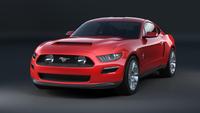Taking the all-new Ford Mustang from sketch to production

For a car designer, the chance to reimagine an icon like Ford Mustang is always exciting. Doing this for the famous Ford performance car’s 50th anniversary is the opportunity of a lifetime.
By mid-2009, with the substantially updated fifth-generation Ford Mustang in production, Ford designers, engineers and marketers turned their collective attention to what would come next: the design that would mark more than five decades of continuous Mustang development and production.
“To the people inside Ford, Mustang is considered the heart and soul of the company,” said Moray Callum, Ford vice president of global design. “We spent a lot of time amongst the team and with customers discussing the history of Mustang and what it meant to people and concluded that we needed to move forward with a modern design that retained the essence of the brand.”
What makes a Mustang?
As Ford’s performance leader, the basic parameters of Mustang were obvious: rear-wheel drive combined with the sound and performance of a V8 engine to create the visceral experience that Mustang drivers expect.
Part of the appeal of Mustang over the years has been the way it combines style, performance and everyday usability thanks to its four-seat cabin and sizable trunk. These attributes had to be part of the new design. With these basic parameters, Ford designers established a footprint to work with roughly the same as the fifth generation model.
From a design stand point, the challenge was how to design a car that was contemporary, but unmistakably Mustang. The goal was to create a Mustang with a bold, aggressive face, with chiseled detailing on the body and a more athletic stance on its tyres.
The process kicks off
A typical new car program kicks off with a design brief that lays out the needs and wants for the upcoming vehicle. However, with 50 years of continuous development and production, every designer knew what to sketch and how a Mustang needs to look.
Several hundred sketches were submitted in early 2010 incorporating many of the primary Mustang DNA cues to varying degrees. The long hood/short deck, bold grille, shark-front nose, fastback profile, side hockey stick contour and rear tri-bar taillamps were reinterpreted in dozens of different ways.
Similarly, sketches of the interior featured the distinctive symmetrical instrument panel with a double brow design and large analogue gauges.
“There are a few key elements that make Mustang a Mustang. As designers, we need to edit those cues deciding which ones to retain, how to interpret them in a modern way and how to combine them to create a car that is immediately identifiable as Mustang,” added Callum. “Looking at all of the different Mustangs over the past five decades, those cues have appeared in some years and not in others, but the end result was still a Mustang.”
Perhaps the most prominent of those cues that did not make the final cut was the scoop, or “hockey stick” profile, on the flanks of the car. Many of the early proposals included some form of this visual feature, but ultimately it was not included in the final production model.
Throughout 2011, hundreds of initial sketches were narrowed down to a handful of proposals that would be transformed into an initial batch of clay models for evaluation in three dimensions. After further development, three themes went into the final selection phase in early 2012.
The 2015 Mustang theme is selected
By the summer of 2012-as with all previous generations- the main Dearborn, Michigan, studio took the lead on developing the Mustang into a production car.
Designers, clay sculptors and digital modelers spent countless hours refining the lines and surfaces that create the three dimensional body side and the powerful hunches as well as the long-sculpted hood with a forward leaning nose that give the 2015 Mustang its unique look and personality.
Details such as the shape and size of the grille and headlamps were refined and the rear track was widened by 70mm, giving the new car an even more aggressive stance.
The elimination of the front and rear bumper shelves and the use of unified side glass with the B-pillar hidden behind the rear quarter windows contribute to the new Mustang’s more contemporary shape.
On the interior, the team paid close attention to the relationships of the various elements, and designed them in a way to achieve optimum fit and finish. The final theme was inspired by the wing of an airplane, with the double brow carved out of the wing. All the gauges, registers, toggle switches and other design elements are placed into the wing. Everything is where it needs to be for usability, just like the cockpit of an airplane. The toggle switches are a highlight of the modern center stack.
The designers have also taken advantage of modern lighting technology at both ends of the car. Indirect LEDs illuminate the blade style tri-bar taillamps with a uniform glow. LEDs are also used for the three gills mounted inboard of the high-intensity discharge headlamps, recalling the gills molded into the headlamp buckets of the original 1965 Mustang.
Along the way, the shape of the new Mustang underwent twice as much aerodynamic testing as any previous generation.
The convertible
The convertible is clearly part of the same product family as the fastback and yet much of the bodywork is actually unique to the open-top car. Subtle but important differences in the shape of the rear bodywork give the convertible a cohesive shape of its own.
From the raised and straightened muscle line on the rear haunches to the recontoured bootlid, the new Mustang convertible has a more linear quality whether the top is up or down, giving the car its own distinct presence on the road.
The final production design of the all-new sixth-generation Ford Mustang was revealed to the world in December 2013 and will be available in UK dealerships by the end of 2015.

